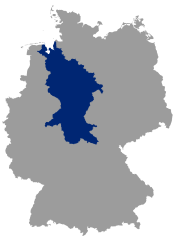Weser basin: flood, low flow, hydrometeorological conditions, water quality

The River Werra, originating in the Thuringian Forest and the River Fulda, flowing out of the Rhön Mountains, unite in the town Hannoversch Münden to the River Weser. The Upper Weser transforms at the Porta Westfalica into the Middle Weser and flows through the North German Plain. The tidal stretch of the Weser starts at the lock in Bremen-Hemelingen and flows into the North Sea at Bremerhaven. The total length of the Weser is 427 km: Upper and Middle Weser have a combined length of 362 km, the tidal Weser only 65 km.
The Weser chainage used for shipping and navigation begins at the confluence of the Werra and Fulda (km 0.0) and ends at river kilometer 366.72 (Wilhelm-Kaisen-Bridge, Bremen), where a new count (km 0.0 to 85.25) for the Lower Weser starts.
The Weser river basin district also includes the Jade catchment area and has a total size of around 49000 sq. km. This area is completely within Germany and extends over the federal states of Lower Saxony (60.1 %), Hesse (18.4 %), North Rhine-Westphalia (10.1 %), Thuringia (9.1 %) and Saxony-Anhalt, Bremen and Bavaria with significantly smaller shares. [1]
In addition to the headwaters Werra and Fulda, leftsided the Diemel, Werre, Große Aue, Ochtum and Hunte as well as the Aller and Lesum on the right-hand side are significant Weser tributaries.
Water protection and flood risk management measures on the Weser and its tributaries are coordinated by:

Weser:
Selection of gauges / water quality monitoring stations

Weser:
Current hydrometeorological conditions

Weser:
Extreme floods / low flows

Weser:
Current water temperature / oxygen content

Weser:
Current electric conductivity / pH-Value
Overview Weser basin
- FGG Weser: Die Weser und ihr Einzugsgebiet
- FGG Weser (Hrsg.) (2004): Bestandsaufnahme in der Flussgebietseinheit Weser
- Bundesministerium für Umwelt, Naturschutz und Reaktorsicherheit (Hrsg.) (2000 - 2003): Hydrologischer Atlas von Deutschland (HAD)
Water quality
- [1] FGG Weser (Hrsg.) (2009 / 2016 / 2021): Bewirtschaftungsplan für die Flussgebietseinheit Weser
- FGG Weser (Hrsg.) (2021): Detaillierter Bewirtschaftungsplan bzgl. der Salzbelastung 2021 bis 2027 einschl. der Anhänge (Art. 13 Abs. 5 EG-WRRL)
- FGG Weser (Hrsg.) (2008): Überwachung der Gewässer in der Flussgebietseinheit Weser [nach Art. 8 der EG-WRRL]
- FGG Weser: Gewässerdaten für FGG-Weser-Messstellen (ab 1979 bis 2015 als Jahres-Datensatz)
- FGG Weser: Weserdatenbank (Daten zur chemisch-physikalischen Wasserbeschaffenheit)
- Niedersächsischer Landesbetrieb für Wasserwirtschaft, Küsten- und Naturschutz: Landesdatenbank für wasserwirtschaftliche Daten
- Senator für Umwelt, Bau und Verkehr Bremen: Oberflächengewässer (Messdaten, Berichte, ...)
- Hessisches Landesamt für Naturschutz, Umwelt und Geologie: Fließgewässer - Chemie (aktuelle Messdaten)
- Ministerium für Umwelt, Landwirtschaft, Natur- und Verbraucherschutz Nordrhein-Westfalen: Wasserinformationssystem ELWAS
- Landesamt für Natur, Umwelt und Verbraucherschutz Nordrhein-Westfalen: HYGON (Hydrologische Rohdaten Online)
- Thüringer Landesamt für Umwelt, Bergbau und Naturschutz: Gewässergüte (Qualität der Fließgewässer, Monitoringergebnisse, ...)
- Umweltbundesamt (Hrsg.) (2017a): Gewässer in Deutschland: Zustand und Bewertung
- Umweltbundesamt (Hrsg.) (2017b): Wasserwirtschaft in Deutschland - Grundlagen, Belastungen, Maßnahmen
- Umweltbundesamt (Hrsg.) (2022): Die Wasserrahmenrichtlinie - Gewässer in Deutschland 2021
- Umweltbundesamt (Hrsg.): Geographisches Informationssystem Umwelt
- European Environment Agency: Water quality monitoring stations (Karte der Messstellen der Wasserbeschaffenheit (Flüsse [und Kanäle], Seen [und Talsperren], Grundwasser, Übergangs-, Küsten- und Meeresgewässer) für die EU-Berichterstattung)
- European Environment Agency: Waterbase - Water Quality (Daten zur Wasserbeschaffenheit der Gewässer in Europa)
Accidental water pollution, warning and alarm plans
- FGG Weser: Warnplan Weser
Flood / low flow
- FGG Weser (2021): Hochwasserrisikomanagementplan für die Flussgebietseinheit Weser
- FGG Weser: Hintergrunddokumente der Länder zum Hochwasserrisikomanagement
- Niedersächsischer Landesbetrieb für Wasserwirtschaft, Küsten- und Naturschutz: Informationsportal Hochwasserschutz
- Hessisches Landesamt für Naturschutz, Umwelt und Geologie: Hochwasser / Überschwemmungsgebiete
- Landesamt für Natur, Umwelt und Verbraucherschutz Nordrhein-Westfalen: Hochwasserschutz
- Senator für Umwelt, Bau und Verkehr Bremen: Hochwasserschutz - Risikomanangement
- Waldeck/Edersee: Wasserstand Edersee
- Bundesanstalt für Gewässerkunde: Hochwassergefahren und -risikokarten (für alle Bundesländer)
Research projects / programmes
- PLAWES: Mikroplastikkontamination im Modellsystem Weser - Nationalpark Wattenmeer: ein ökosystemübergreifender Ansatz; Koordinierung: Universität Bayreuth und Alfred-Wegener-Institut Helmholtz-Zentrum für Polar- und Meeresforschung, Laufzeit 2017 - 2020
